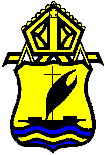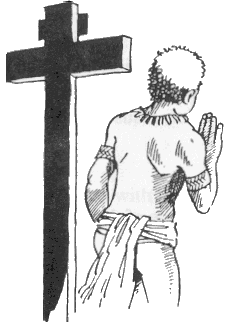
Anglican Church

OBITUARY: Bishop David G. Hand, KBE , MA , ThD,
Grand Chief of the Order of the Logohu,
by the Right Reverend Peter Fox, Bishop of Port Moresby.
“If I don’t come out of it just be content that I have tried to do my job faithfully.” These words, were written in haste from “Somewhere in the Papuan bush” by a young English priest called Vivian Redlitch. The date was the 27 th. July, 1946. Japanese troops had landed. He would be dead within weeks of writing, another in the list of “New Guinea Martyrs”. The letter, on display at St. Paul ’s Cathedral, London , was to have a profound effect on the young David Hand. He came to feel that God was calling him to continue Father Vivian’s work.
David Geoffrey Hand arrived in Port Moresby , now the National Capital of Papua New Guinea on the 28 th. November, 1946, fresh from his curacy in Heckmondwike in West Yorkshire . A mere four years later he was consecrated bishop, at thirty-two the youngest bishop in the Anglican Communion. Serving first as assistant bishop to Philip Strong, he succeeded him as Diocesan Bishop of New Guinea in 1963 and became the first Archbishop of the newly independent Anglican Province of Papua New Guinea in 1977. When he retired in 1983 as Archbishop of PNG and Diocesan Bishop of Port Moresby it marked the end of an episcopal career that spanned thirty-three years.
He had come to Papua New Guinea at a time when the Anglican Mission was struggling to recover after the devastation of the Second World War. Then on the 21 st. January, 1951, Mount Lamington volcano erupted with dreadful consequences, destroying clinics, schools and churches, and killing thousands of people, including priests, teachers and medical staff; whole families were killed. Many of those who died were Bishop David’s dearest friends, but his personal grief had to take second place to the pressing need to care for the survivors and restore the Mission ’s work.
In the years following the Mount Lamington Disaster, Bishop David concentrated much of his effort on expansion of the Anglican Mission into hitherto un-evangelized areas in the New Guinea Highlands, especially along the Jimi Valley , Simbai and Siani. He travelled largely on foot, his knapsack holding little except his Bible, prayer book, bread and wine, into areas where few outsiders had ever been, and from which fewer still had returned. Wherever he went new congregations were born.
Bishop David did not seek the easy path at any time but perhaps of all the challenges he had to face the greatest was the beginning of Independence for the Nation now called Papua New Guinea and for the new Anglican Province . Formerly, the Anglican Mission had operated within a colonial structure. Its funding and most of its professional staff had been provided by the Church overseas. The Diocesan Bishop had been solely responsible for all appointments and most policy decisions. Now, as Archbishop of the new Anglican Church of Papua New Guinea, David Hand was to preside over a shift from dependence towards increasing self-reliance, and from a monarchical to a synodical pattern of decision-making. The Anglican Church of Papua New Guinea was to become truly indigenous in its leadership and style under his encouragement; its liturgy incorporating traditional dance, song and symbolism.
On the other hand, while culturally the Anglican Church was rich, financially it was and remains desperately poor. In an attempt to provide a measure of security for the Church on the eve of Independence as well as witness to the close friendship that existed amongst the major Christian denominations, Bishop David joined with Doctor Marcus Loane, Archbishop of Sydney, Doctor Virgil Copas, the Roman Catholic Archbishop of Port Moresby, Bishop Ravu Henao of the United Church, and Archdeacon John Reid, in a walk from Buna to Ela Beach. Remembered simply as “The Bishop’s Walk of 1972” the journey covered a distance of some one hundred and fifty miles, across some of the toughest terrain in Papua New Guinea , over the Mount Lamington Range , through jungle and river, via the notorious Kokoda Trail. It became the stuff of legend.
In 1983 Bishop David Hand retired as Archbishop of Papua New Guinea and Diocesan Bishop of Port Moresby . His successors in both roles were Papua New Guinean, something that would have been almost unimaginable thirty years earlier.
In order to ease matters for his successors Bishop David returned to his childhood home to serve briefly as priest-in-charge of the group of parishes in rural Norfolk which included Tatterford, the tiny village where David’s father, the Reverend William Thomas Hand, had once been Rector and where David had grown up. There were still people in the village who remembered David Hand as a young boy growing up along with his brothers, Peter and Eustace (nicknamed “Bink”), both of whom had also been ordained. Incredibly, his old nurse, Mrs. Edna Graver, still lived in the village at that time.
That brief return to English parish life was a very special time for Bishop David but it was also, in a sense, a last farewell. He had taken Papua New Guinean citizenship many years earlier, and it was always his hope that he would eventually live out his days and his body would be laid to rest, in his beloved PNG.
He may have been retired but Bishop David was far from inactive. He served for a period with PNG’s newly established Censorship Board and wrote a regular column in “The Times of PNG”, a major national newspaper. To the end he maintained his pastoral and sacramental concern for others and was a familiar figure in public life. With the writing of his autobiography “Modawa – Papua New Guinea and Me”, published in 2002, he gave historians of PNG a wonderful new resource. Interestingly, as he drew near to the end of his life Bishop David returned again to the story of Father Vivian Redlitch who had been his early inspiration. In his book, “Modawa”, he revealed that he had uncovered new information about the manner of Redlitch’s death, and that he had been murdered by Orokaiva people and not the Japanese. He hoped to uncover the truth so that the past could be decently laid to rest along with Fr. Vivian’s mortal remains.
Advancing years brought many signs of the Nation’s gratitude for David Hand. Prior to retirement he had been awarded the KBE, although he rarely let himself be addressed as Sir David. One of his last public engagements was on the occasion of HRH Princess Anne’s visit to Papua New Guinea in September, 2005, when he was one of the first people to be invested as Grand Chief in the newly created Order of the Logohu.
Deeply appreciative of the respect and love in which he was held Bishop David was not enamoured of fancy titles and honorifics for their own sake. After retirement he refused to be addressed as “Your Grace” or Archbishop. “Archbishop used to be my job,” he would say, “but a bishop is what I am.” He would say, “There is no more appropriate title for any priest or bishop than ‘Father’.” Many are the Papua New Guineans, unrelated by blood, who thought it perfectly natural to call this holy and humble man “Grandfather”.
He died peacefully on the 6 th. April, 2006, in Pacific International Hospital , surrounded by people who loved him and whom he loved, a large adopted family of all ages.
After a Requiem Service at St. Mary’s Anglican Church, Gerehu, on Easter Tuesday, the 18th. April, Bishop David’s body will be flown home on Wednesday, the 19th. April for burial at The Cathedral of the Resurrection, Popondetta.
